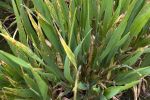At least twice a year, Queensland Department of Primary Industries (DPI) research agronomist Andrew Erbacher and his team head to Tom Woods’s farm at Goondiwindi to take soil samples.
For the past decade, Mr Woods has hosted the GRDC-supported Northern Farming Systems trials at Woods Pastoral’s Billa Billa property, with the Queensland DPI.
The soil samples taken coincide with pre-harvest and post-harvest or the midpoint in a long fallow. The information gathered includes soil water details, mineral nitrogen dynamics and soil-borne disease inoculum loads.
In reality, Mr Erbacher catches up with Mr Woods and agronomist Stuart Thorn, from MCA Agronomy, a bit more often than these biannual visits.“When we’re onsite, Tom will pop out and say hello. Plus, Tom and Stuart are on our reference group panel,” Mr Erbacher says. “We really appreciate not just Tom’s generosity, but also his and Stuart’s dedication to the research.”
Mr Woods is a research enthusiast. “I would like to think that this research will continue. Farming systems take a long time to develop. You think you’ve got one sorted then you find a problem hiding in the wings.”
Farming systems research
The Northern Farming Systems project set out to represent the dynamic nature of cropping in the north where plant-available water triggers cropping decisions.
Across the project, experiments occurred at seven locations: a core experimental site comparing 38 farming systems at Pampas near Toowoomba, and a further six regional sites from central Queensland to central NSW.
At these regional sites, six to eight systems are tested: a baseline system representing local best practice is modified for higher nutrient, higher legume, higher diversity, and higher and lower cropping intensity systems.
System modifications have been beneficial at some sites, but at Billa Billa the baseline system performs significantly better than any of the others.
Mr Thorn says the results validate what the MCA Group and the Woodses have “spent a long time trying to perfect”. Lessons about soil water availability have been key, he says.
What stood out for me was the need to measure and understand soil water before planting. It is critical to making good cropping decisions.
Mr Woods agrees: “For us, preserving moisture feeds into all our decisions.”
For Mr Erbacher, the chance to “play in the sandbox” has been highly valuable. “Tom has allowed me to research farming systems, companion cropping, cover cropping, and have a play with some summer chickpeas.”
He also says the interaction between growers such as Mr Woods and keen agronomists such as Mr Thorn has helped shape and improve the research.
“Tom’s passion and enthusiasm to continue refining the farming system is inspiring and he’s such an advocate, while Stu is always available, and it’s been great to have the agronomic support he provides. Having the support of a grower and an agronomist makes it much easier.”
Read more: Pros and cons of cropping intensity meet at Goondiwindi.

























































